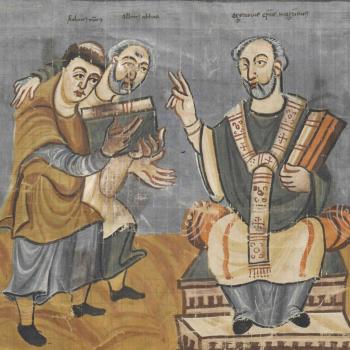This year, we are of course commemorating the centennial of the First World War, and specifically the titanic battles of Verdun and the Somme. My 2014 book The Great and Holy War discusses the religious aspects of the war, but one thing that really struck me about that theme was the very large range of behaviors that I genuinely did not know how to classify as religious or not. That brings me to one wonderful source that still remains woefully under-studied in the English-speaking world.
On all sides, soldiers followed what Paul Fussell has termed “a plethora of very un-modern superstitions, talismans, wonders, miracles, relics, legends, and rumors.” In the words of frontline officer Marc Bloch—later to become one of France’s greatest historians—“The prevailing opinion in the trenches was that anything might be true, except what was printed.”
So prevalent were fatalism and superstition that frontline armies seem to have lived in an alternate spiritual universe more akin to the Middle Ages than the era of tanks and aircraft. Accepting such worldviews was much easier for the millions of soldiers who came from peasant households where folk magic and traditional beliefs still reigned. And that brings me to a magnificent (if short) book that is all too rarely cited in American and British writing. (But see now Patrick J. Houlihan’s excellent Catholicism and the Great War: Religion and Everyday Life in Germany and Austria-Hungary, 1914–1922 (Cambridge 2015).
In 1917, Swiss folklorist Hanns Bächtold-Stäubli published a scholarly analysis of German Soldiers’ Customs and Beliefs, which I don’t believe has ever been translated (Deutscher Soldatenbrauch und Soldatenglaube (Strasbourg: K. J. Trübner, 1917).
Be careful, by the way, as many sources cite the author as “Hanna,” but he was not in fact a pioneering woman scholar! But that Hanna error entered the cataloguing world early on, and in order to find the book, you still have to look it up under “Hanna.” There is a whole bibliographical saga here, and it is all very strange – and still unresolved.
The book makes for astonishing reading, but the basic point is for all sides, it was a war of amulets, apparitions and prophecies. As he remarked, war and the threat of death did a marvelous job of focusing the minds of ordinary men who were suddenly willing to pay avid attention to quite outlandish prophecies and folk beliefs. For both soldiers and their families, the main concerns were natural enough. How would the war develop and when would it end? Answers to both questions lay in such ancient signs as the state of the moon and sun, the flights of birds, all as interpreted by widely circulating verses and pamphlets.
As one German rhyme interpreted the years preceding the war,
1911 ein Glutjahr
1912 ein Flutjahr
1913 ein gut Jahr
1914 ein Blutjahr
1911 A Year of Fire
1912 A Year of Flood
1913 A Good Year
1914 A Year of Blood
Numerology came into its own, as soldiers tried to calculate the war’s end by adding together the digits in special dates such as the beginning and end of the war of 1870–71. One popular attempt cited by Bächtold-Stäubli predicted the end of the current war as November 11, 1915—an impressive coincidence in terms of the month and day, although off by three years on the actual year. The prophecy demonstrates the widespread expectation that such a war could not conceivably last more than a year or so, which helps to explain the stupefied despair that resulted as it dragged on into its fourth and fifth years.
Catholics in particular had access to a rich arsenal of protective supernatural resources, in the form of rosaries and holy medals. A German soldier tasked with burying the dead noted that most of the soldiers bore a medal of the Immaculate Virgin. Devout Catholics wore the scapular, a pair of simple holy images worn over the chest and back and tied together with light woolen cloth over the shoulders. As scapulars were believed to give protection, from 1914 they became hugely popular among the soldiers and sailors of all the fighting nations.
Whether French or German, Irish or Austrian, Catholic groups sent scapulars and holy images to the fighting forces, and anecdotal evidence suggests these were widely accepted, even by individuals whose peacetime politics might have been strongly anti-religious. Protestant soldiers too developed a real affection for crucifixes and the protection they could afford. French Catholic papers delighted in reporting miracles attributed to scapulars and sacred images—of units escaping casualties during artillery barrages, of vital supplies kept safe by the Sacred Heart. Orthodox Russians, Romanians, and Serbs followed their own traditions of supernatural intervention, commonly by the Virgin or the saints.
Even these resources proved inadequate for believing families who sought to equip their menfolk with still stronger spiritual weapons. Bächtold-Stäubli tells of German mothers and wives pronouncing ritual verses and spells before sending men to the front. They even gave them a Schutzbrief, a heaven-sent letter of protection, in a model that would not have been out of place in the Thirty Years War.
As I say, German Soldiers’ Customs and Beliefs raises interesting questions about the frontiers of religion and superstition, and especially the definition of that latter word. It also makes me wonder whether that was in fact the last European war in which soldiers behaved thus? I am not aware (for instance) of any reported Marian apparitions during the Second World War, in contrast to the many of the First. I suspect that the soldiers of the 1940s were more secular and skeptical, but I don’t say that dogmatically. If not for intrepid scholars like Bächtold-Stäubli (and his contemporary Sofia Fedorchenko among the Russians) we just wouldn’t be aware of all this strange stuff going on in the Great War.
Maybe it wasn’t that the superstitions stopped: maybe people just stopped looking for them?
















